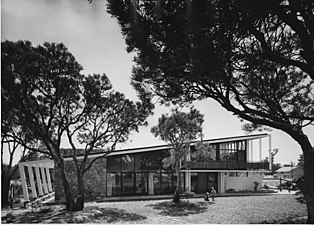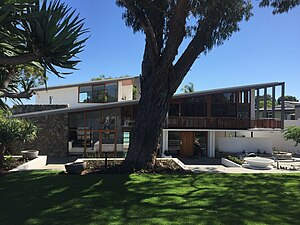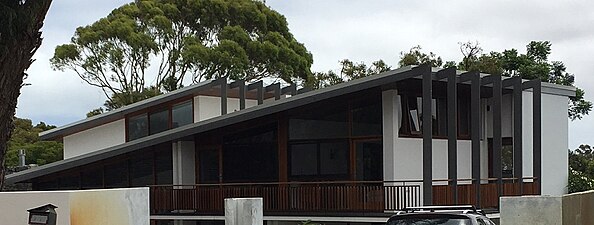| Revision as of 09:22, 4 November 2019 editOrenburg1 (talk | contribs)Extended confirmed users166,384 editsm sp← Previous edit | Revision as of 12:17, 17 February 2021 edit undoAnneyh (talk | contribs)Extended confirmed users1,334 edits →Design: Bauhaus influence needs a reliable source (not in biography / Google scholar)Next edit → | ||
| Line 29: | Line 29: | ||
| In 1959 the German ] in Perth was closed and the house had to be sold. | In 1959 the German ] in Perth was closed and the house had to be sold. | ||
| In contrast to the later more ornamented and playful designs of Iwanoff with some resemblance to ], the light and clear design of this house is inspired by the ] and ] ideas which Iwanoff was introduced to during his studies and work with Emil Freymuth in ].<ref name=BIO/> Characteristic features of this partially single storey, partially double storey house are apart from the distinctive soaring ] line the blending of natural materials granite, timber, copper. It features ] ceilings, ] parquetry floors, ] staircase, ] cupboards, ] benchtops, granite feature walls, a copper-surrounded fireplace.<ref name=AA/> The jarrah framed window front on the south side opened a wide view on the Roscommon Reserve<ref name=RP/> directly opposite. Overall the house shows Iwanoff's tendency to complex composition<ref name=HM/> and with the wall at the southwest corner built from granite boulders Iwanoff already hints his interest in massive structures. The granite wall extends into the interior as a fireplace in the living area and a barbecue pit on the terrace in the west. | In contrast to the later more ornamented and playful designs of Iwanoff with some resemblance to ], the light and clear design of this house is inspired by the ] and ]{{citation needed}} ideas which Iwanoff was introduced to during his studies and work with Emil Freymuth in ].<ref name=BIO/> Characteristic features of this partially single storey, partially double storey house are apart from the distinctive soaring ] line the blending of natural materials granite, timber, copper. It features ] ceilings, ] parquetry floors, ] staircase, ] cupboards, ] benchtops, granite feature walls, a copper-surrounded fireplace.<ref name=AA/> The jarrah framed window front on the south side opened a wide view on the Roscommon Reserve<ref name=RP/> directly opposite. Overall the house shows Iwanoff's tendency to complex composition<ref name=HM/> and with the wall at the southwest corner built from granite boulders Iwanoff already hints his interest in massive structures. The granite wall extends into the interior as a fireplace in the living area and a barbecue pit on the terrace in the west. | ||
| ] | ] | ||
Revision as of 12:17, 17 February 2021
Historic building in Floreat, Australia designed by Iwan Iwanoff 1958| Schmidt-Lademann House | |
|---|---|
 1959 1959 | |
| General information | |
| Type | Residence |
| Architectural style | Modernist |
| Address | 22 Lifford Road |
| Town or city | Floreat, Western Australia |
| Country | Australia |
| Coordinates | 31°56′03″S 115°46′53″E / 31.9342°S 115.7815°E / -31.9342; 115.7815 |
| Completed | 1958 |
| Grounds | 906 ㎡ |
| Design and construction | |
| Architect(s) | Iwan Iwanoff |
The Schmidt-Lademann House is a residential dwelling built 1958 in Floreat, a suburb of Perth, Western Australia. It is designed by Bulgarian-born architect Iwan Iwanoff and is an iconic example of mid-century modern architecture in Australia.
Design
Siegfried Schmidt-Lademann became consul in Perth for Germany in 1957. He decided to build a residence for the consul in Perth which would be suitable for private living and for formal receptions. The house was the first independent design by the architect Iwan Iwanoff and was built in 1958. It became one of Iwanoff's notable projects.
In 1959 the German consulate in Perth was closed and the house had to be sold.
In contrast to the later more ornamented and playful designs of Iwanoff with some resemblance to Brutalist architecture, the light and clear design of this house is inspired by the Modernist architecture and Bauhaus ideas which Iwanoff was introduced to during his studies and work with Emil Freymuth in Munich, Germany. Characteristic features of this partially single storey, partially double storey house are apart from the distinctive soaring skillion roof line the blending of natural materials granite, timber, copper. It features jarrah ceilings, blackbutt parquetry floors, wandoo staircase, maple cupboards, Corian benchtops, granite feature walls, a copper-surrounded fireplace. The jarrah framed window front on the south side opened a wide view on the Roscommon Reserve directly opposite. Overall the house shows Iwanoff's tendency to complex composition and with the wall at the southwest corner built from granite boulders Iwanoff already hints his interest in massive structures. The granite wall extends into the interior as a fireplace in the living area and a barbecue pit on the terrace in the west.
The design of 1958 included a living area on two levels separated by 2 steps into a dining area at the lower level and a sitting area with fireplace on the higher level, 3 bedrooms, a study on the gallery, a kitchen and 1.5 bathrooms.

History
In 2003 the house received an extension filling out the previous "L" shape on the northwest side with a two-storey block adding an indoor/outdoor dining area on the ground floor and a bedroom and bathroom on the upper floor. This addition merges very well with the original design especially where it repeats the slanted roof.
The residence is listed in the Town of Cambridge Local Government Inventory of Heritage Places as place no. 39.
It has changed ownership several times and increased in value each time: June 1989 $255,000, February 1998 $440,000, June 2012 $2,300,000.
Gallery
- Exterior, south side, 1959 vs. 2017 showing how the 2003 extension merges with the original design
-
 1959
1959
-
 2017
2017
-
 2017
2017
- Interior
-
 1959 living area
1959 living area
-
 1959 entrance hall in typical Bauhaus style
1959 entrance hall in typical Bauhaus style
Notes
- In various publications e.g. Town of Cambridge Inventory of Heritage Places and internet websites the house is referred to by the name of the builder and first owner Siegfried and Jutta Schmidt-Lademann
References
- ^ Town of Cambridge: Local Government Inventory of Heritage Places (PDF), Town of Cambridge, pp. 216–219, retrieved 2019-03-31, alternatively: Website to download document (3rd document)
- ^ Margalit, Harry (2019), Australia, modern architectures in history, London: Reaktion Books Ltd, pp. 164–165, ISBN 978 1 78914 124 5
- ^ "House in Perth", Architecture and Arts, no. May 1959, Melbourne, pp. 40–41, retrieved 2019-03-31
- "Iwanoff, Iwan (1919–1986)", Australian Dictionary of Biography, retrieved 2019-03-31
- Roscommon Park, Town of Cambridge, retrieved 2019-03-31
- Consumer Price Index Inflation Calculator, Australian Bureau of Statistics, retrieved 2019-04-29, (please note decimalisation 1£=2$)
- "Property Report for 22 Lifford Road, Floreat WA 6014 – property profile with price history", Domain, Domain Holdings Australia, retrieved 2019-03-31
External links
 Picture gallery, Schmidt-Lademann House at Wikimedia Commons
Picture gallery, Schmidt-Lademann House at Wikimedia Commons- Iwanoff's Cambridge Legacy Made by Town of Cambridge
- Interviews with Jutta Schmidt-Lademann and Michael Iwanoff about this house
- Schmidt-Lademann house
- 6000TIMES: Perth, Australia : Best House in the Universe as We Know It
- Gallery of 23 recent pictures taken 2012
![]() Wikidata: Schmidt-Lademann House (Q63117684)
Wikidata: Schmidt-Lademann House (Q63117684)